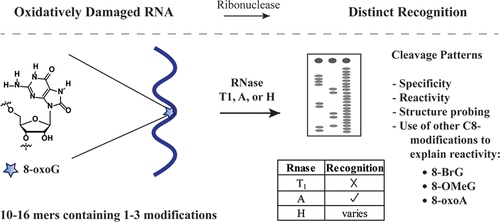当前位置:
X-MOL 学术
›
Biochemistry
›
论文详情
Our official English website, www.x-mol.net, welcomes your
feedback! (Note: you will need to create a separate account there.)
Reactivity and Specificity of RNase T1, RNase A, and RNase H toward Oligonucleotides of RNA Containing 8-Oxo-7,8-dihydroguanosine
Biochemistry ( IF 2.9 ) Pub Date : 2018-04-23 00:00:00 , DOI: 10.1021/acs.biochem.8b00277 Cassandra Herbert 1 , Yannick Kokouvi Dzowo 1 , Anthony Urban 1 , Courtney N. Kiggins 1 , Marino J. E. Resendiz 1
Biochemistry ( IF 2.9 ) Pub Date : 2018-04-23 00:00:00 , DOI: 10.1021/acs.biochem.8b00277 Cassandra Herbert 1 , Yannick Kokouvi Dzowo 1 , Anthony Urban 1 , Courtney N. Kiggins 1 , Marino J. E. Resendiz 1
Affiliation

|
Understanding how oxidatively damaged RNA interacts with ribonucleases is important because of its proposed role in the development and progression of disease. Thus, understanding structural aspects of RNA containing lesions generated under oxidative stress, as well as its interactions with other biopolymers, is fundamental. We explored the reactivity of RNase A, RNase T1, and RNase H toward oligonucleotides of RNA containing 8-oxo-7,8-dihydroguanosine (8oxoG). This is the first example that addresses this relationship and will be useful for understanding (1) how these RNases can be used to characterize the structural impact that this lesion has on RNA and (2) how oxidatively modified RNA may be handled intracellularly. 8-OxoG was incorporated into 10–16-mers of RNA, and its reactivity with each ribonuclease was assessed via electrophoretic analyses, circular dichroism, and the use of other C8-purine-modified analogues (8-bromoguanosine, 8-methoxyguanosine, and 8-oxoadenosine). RNase T1 does not recognize sites containing 8-oxoG, while RNase A recognizes and cleaves RNA at positions containing this lesion while differentiating if it is involved in H-bonding. The selectivity of RNase A followed the order C > 8-oxoG ≈ U. In addition, isothermal titration calorimetry showed that an 8-oxoG–C3′-methylphosphate derivative can inhibit RNase A activity. Cleavage patterns obtained from RNase H displayed changes in reactivity in a sequence- and concentration-dependent manner and displayed recognition at sites containing the modification in some cases. These data will aid in understanding how this modification affects reactivity with ribonucleases and will enable the characterization of global and local structural changes in oxidatively damaged RNA.
中文翻译:

RNase T 1,RNase A和RNase H对含有8-Oxo-7,8-dihydroguanosine的RNA的寡核苷酸的反应性和特异性
了解氧化损伤的RNA如何与核糖核酸相互作用非常重要,因为它在疾病的发展和进程中具有拟议的作用。因此,了解包含在氧化应激下产生的损伤的RNA的结构方面及其与其他生物聚合物的相互作用是至关重要的。我们探索了RNase A,RNase T 1的反应性,以及RNase H指向含有8-oxo-7,8-dihydroguanosine(8oxoG)的RNA寡核苷酸。这是解决该关系的第一个例子,对于理解(1)如何使用这些RNase表征该病变对RNA的结构影响以及(2)如何在细胞内处理氧化修饰的RNA很有用。将8-OxoG掺入10–16-mer RNA中,并通过电泳分析,圆二色性和使用其他C8嘌呤修饰的类似物(8-溴鸟苷,8-甲氧基鸟苷和8-氧代腺苷)。核糖核酸酶T 1RNase A不能识别包含8-oxoG的位点,而RNase A可以识别并切割包含该病变的位置的RNA,同时区分是否参与H键。RNase A的选择性遵循C> 8-oxoG≈U的顺序。此外,等温滴定量热法显示,8-oxoG–C3'-甲基磷酸酯衍生物可以抑制RNase A的活性。从RNA酶H获得的切割模式在某些情况下以序列和浓度依赖性的方式显示出反应性的变化,并且在包含该修饰的位点上显示出识别性。这些数据将有助于理解这种修饰如何影响与核糖核酸酶的反应性,并能够表征氧化损伤的RNA的整体和局部结构变化。
更新日期:2018-04-23
中文翻译:

RNase T 1,RNase A和RNase H对含有8-Oxo-7,8-dihydroguanosine的RNA的寡核苷酸的反应性和特异性
了解氧化损伤的RNA如何与核糖核酸相互作用非常重要,因为它在疾病的发展和进程中具有拟议的作用。因此,了解包含在氧化应激下产生的损伤的RNA的结构方面及其与其他生物聚合物的相互作用是至关重要的。我们探索了RNase A,RNase T 1的反应性,以及RNase H指向含有8-oxo-7,8-dihydroguanosine(8oxoG)的RNA寡核苷酸。这是解决该关系的第一个例子,对于理解(1)如何使用这些RNase表征该病变对RNA的结构影响以及(2)如何在细胞内处理氧化修饰的RNA很有用。将8-OxoG掺入10–16-mer RNA中,并通过电泳分析,圆二色性和使用其他C8嘌呤修饰的类似物(8-溴鸟苷,8-甲氧基鸟苷和8-氧代腺苷)。核糖核酸酶T 1RNase A不能识别包含8-oxoG的位点,而RNase A可以识别并切割包含该病变的位置的RNA,同时区分是否参与H键。RNase A的选择性遵循C> 8-oxoG≈U的顺序。此外,等温滴定量热法显示,8-oxoG–C3'-甲基磷酸酯衍生物可以抑制RNase A的活性。从RNA酶H获得的切割模式在某些情况下以序列和浓度依赖性的方式显示出反应性的变化,并且在包含该修饰的位点上显示出识别性。这些数据将有助于理解这种修饰如何影响与核糖核酸酶的反应性,并能够表征氧化损伤的RNA的整体和局部结构变化。


















































 京公网安备 11010802027423号
京公网安备 11010802027423号